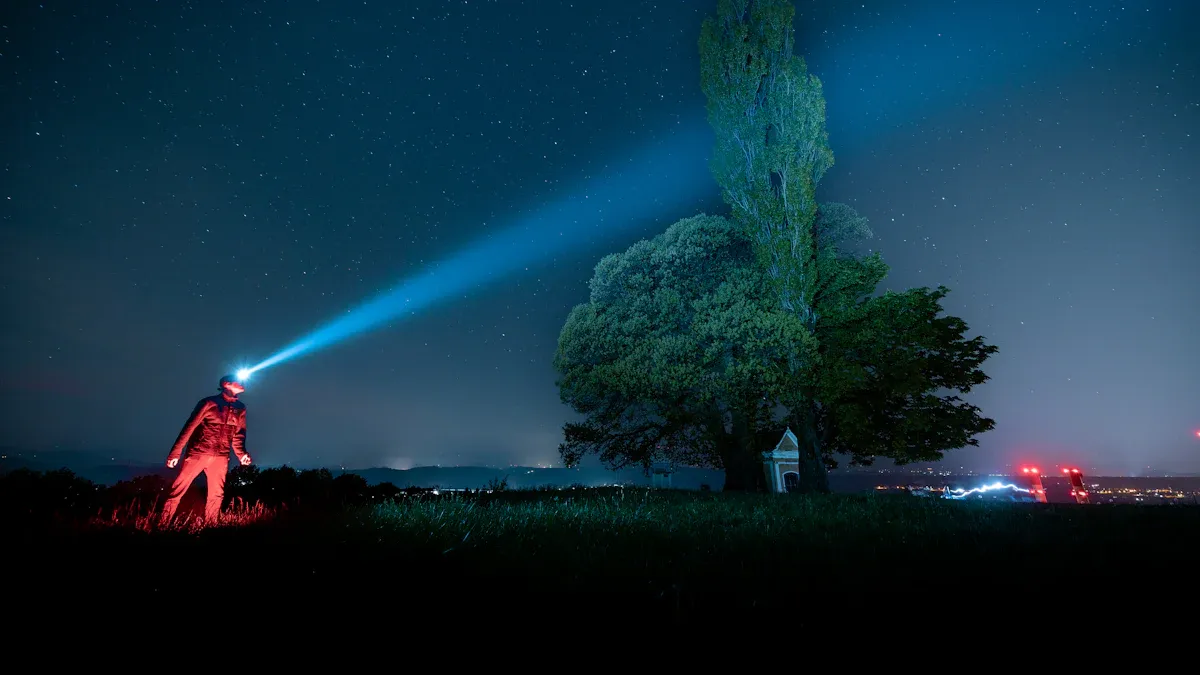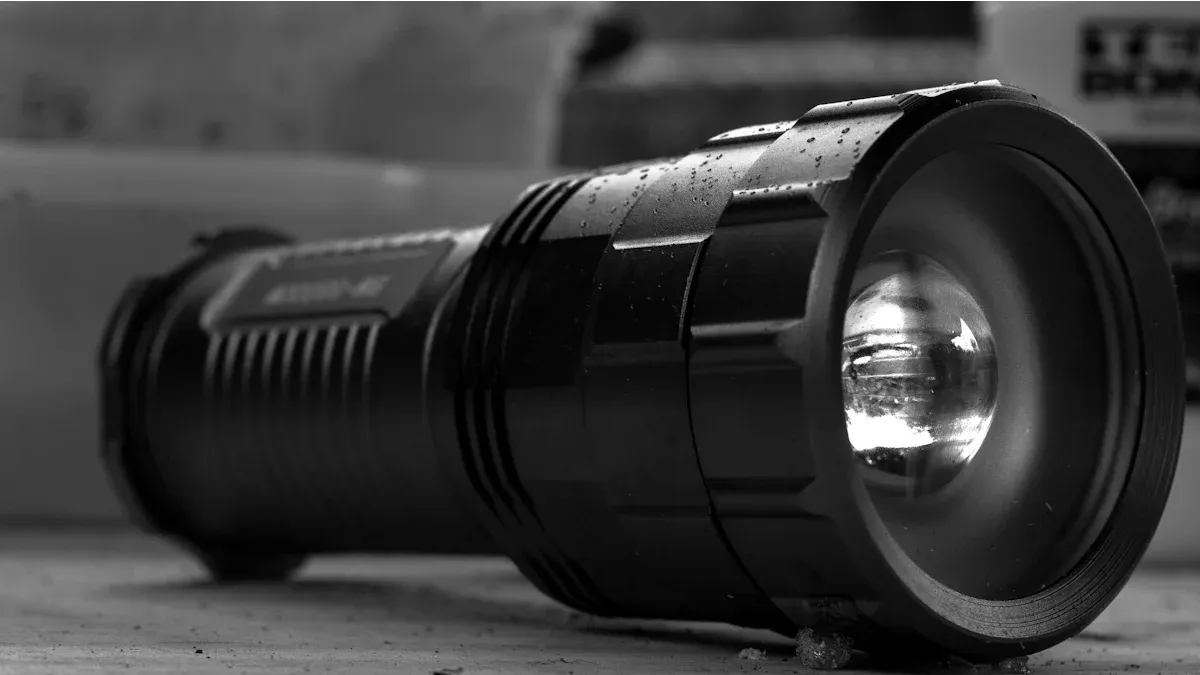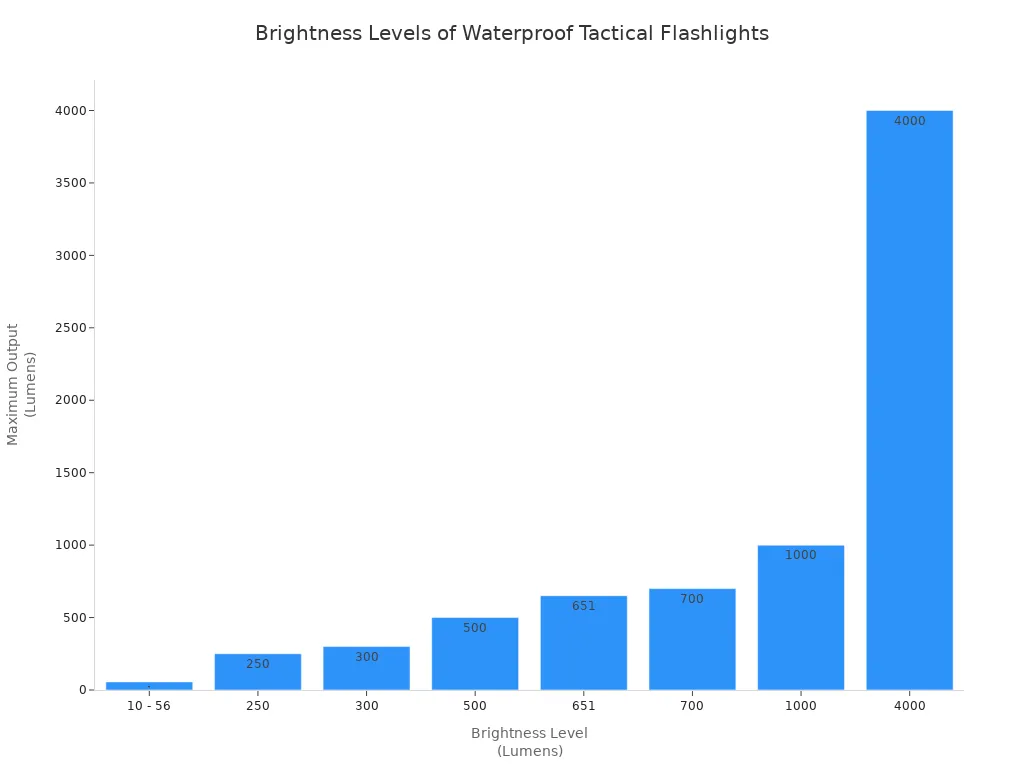
You know that nature can be unpredictable. Rain, mud, and darkness often catch you off guard. Waterproof Tactical Flashlights help you stay ready for anything. You get bright, reliable light even when the weather turns rough. With one in your pack, you feel safer and more prepared.
Key Takeaways
- Waterproof tactical flashlights offer bright, reliable light and strong durability, making them perfect for tough outdoor conditions like rain, snow, and water crossings.
- Look for flashlights with high waterproof ratings (IPX7 or IPX8), impact resistance, multiple lighting modes, and rechargeable batteries to stay prepared and safe on any adventure.
- Regular maintenance, such as checking seals and cleaning, helps your flashlight last longer and perform well when you need it most.
Waterproof Tactical Flashlights: Essential Benefits

What Sets Waterproof Tactical Flashlights Apart
You might wonder what makes these flashlights so special. Waterproof Tactical Flashlights stand out from regular flashlights in many ways. Here’s what you get when you choose one:
- Brighter light output, often reaching over 1,000 lumens, so you can see farther and clearer at night.
- Tough materials like aircraft-grade aluminum and stainless steel, which handle drops and rough use.
- Waterproof and weather-resistant design, letting you use your flashlight in rain, snow, or even underwater.
- Multiple lighting modes, such as strobe or SOS, for emergencies or signaling.
- Zoom and focus features, giving you control over the beam.
- Rechargeable batteries and built-in holsters for convenience.
- Defensive features, like a bright strobe, that can help you stay safe if you ever feel threatened.
Manufacturers highlight these features in their marketing. They want you to know that these flashlights are not just for lighting your way—they are tools for safety, survival, and peace of mind.
Why Waterproofing Is Critical Outdoors
When you head outdoors, you never know what the weather will do. Rain can start suddenly. Snow can fall without warning. Sometimes, you might even need to cross a stream or get caught in a downpour. If your flashlight fails in these moments, you could be left in the dark.
Waterproof Tactical Flashlights keep working even when wet. Their sealed casings, O-rings, and corrosion-resistant materials stop water from getting inside. You can trust your flashlight to shine bright in heavy rain, snow, or even after being dropped in a puddle. This reliability is why outdoor pros, like search and rescue teams, choose waterproof models. They know that a working flashlight can mean the difference between safety and danger.
Tip: Always check the IP rating on your flashlight. An IPX7 or IPX8 rating means your light can handle serious water exposure, from rainstorms to full submersion.
Durability and Performance in Harsh Conditions
You need gear that can take a beating. Waterproof Tactical Flashlights are built for tough environments. They pass strict tests for drops, shocks, and extreme temperatures. Many models use hard anodized aluminum, which resists scratches and corrosion. Some even meet military standards for durability.
Here’s a quick look at what makes these flashlights so tough:
| Material/Method | How It Helps You Outdoors |
|---|---|
| Aerospace-grade aluminum | Handles drops and bumps, resists rust |
| Stainless steel | Adds strength and fights corrosion |
| Hard anodizing (Type III) | Stops scratches and keeps your flashlight looking new |
| O-ring seals | Keeps water and dust out |
| Heat dissipating fins | Prevents overheating during long use |
| Impact-resistant design | Survives falls and rough handling |
| Waterproof ratings (IPX7/IPX8) | Lets you use your flashlight in rain or underwater |
Some tactical flashlights even work after being dropped from six feet or left in freezing cold. You can count on them for camping, hiking, fishing, or emergencies. They keep shining when other lights fail.
Key Features of Waterproof Tactical Flashlights

Waterproof Ratings and Impact Resistance
When you pick a flashlight for outdoor adventures, you want to know it can handle water and drops. Waterproof tactical flashlights use special ratings called IPX ratings. These ratings tell you how much water the flashlight can take before it stops working. Here’s a quick guide:
| IPX Rating | Meaning |
|---|---|
| IPX4 | Resists water splashes from all directions |
| IPX5 | Protected against low pressure water jets from any direction |
| IPX6 | Withstands high pressure water jets from any direction |
| IPX7 | Waterproof when submerged up to 1 meter for 30 minutes; suitable for most tactical uses except prolonged underwater use |
| IPX8 | Can be continuously submerged beyond 1 meter; exact depth specified by manufacturer; ideal for diving or extended underwater activities |
You might see IPX4 on a flashlight that can handle rain or splashes. IPX7 means you can drop it in a stream, and it will still work. IPX8 is even tougher, letting you use your light underwater for longer times.
Impact resistance is just as important. You don’t want your flashlight to break if you drop it. Manufacturers test these flashlights by dropping them from about four feet onto concrete. If the flashlight keeps working, it passes. This test makes sure your light can survive rough hikes, falls, or bumps in your backpack.
Note: Flashlights that meet the ANSI/PLATO FL1 standard go through impact tests before waterproof tests. This order helps make sure the flashlight stays tough in real-life situations.
Brightness Levels and Lighting Modes
You need the right amount of light for every situation. Waterproof tactical flashlights give you many choices. Some models let you pick from low, medium, or high brightness. Others have special modes for emergencies.
Here’s a look at typical brightness levels:
| Brightness Level (Lumens) | Description / Use Case | Example Flashlights |
|---|---|---|
| 10 - 56 | Low output modes on adjustable flashlights | FLATEYE™ Flat Flashlight (Low mode) |
| 250 | Lower mid-range output, waterproof models | FLATEYE™ Rechargeable FR-250 |
| 300 | Minimum recommended for tactical use | General recommendation |
| 500 | Balanced brightness and battery life | General recommendation |
| 651 | Medium output on adjustable flashlight | FLATEYE™ Flat Flashlight (Med mode) |
| 700 | Versatile for self-defense and illumination | General recommendation |
| 1000 | Typical high output for tactical advantage | SureFire E2D Defender Ultra, Streamlight ProTac HL-X, FLATEYE™ Flat Flashlight (High mode) |
| 4000 | High-end tactical flashlight output | Nitecore P20iX |

You might use a low setting (10 lumens) for reading in your tent. A high setting (1,000 lumens or more) helps you see far ahead on a dark trail. Some flashlights even reach 4,000 lumens for extreme brightness.
Lighting modes make your flashlight even more useful. Many models offer:
- Flood and spot beams: Flood lights up a wide area. Spot focuses on one point far away.
- Low or moonlight mode: Saves battery and keeps your night vision.
- Strobe or SOS: Helps you signal for help in emergencies.
- RGB or colored lights: Useful for signaling or reading maps at night.
You can switch modes quickly, even with gloves on. This flexibility helps you handle any outdoor challenge.
Battery Life and Charging Options
You don’t want your flashlight to die when you need it most. That’s why battery life and charging options matter. Many waterproof tactical flashlights use rechargeable batteries. Some models, like the XP920, let you charge with a USB-C cable. You just plug it in—no need for a special charger. A built-in battery indicator shows red when charging and green when ready.
Some flashlights also let you use backup batteries, like CR123A cells. This feature helps if you run out of power far from home. You can swap in new batteries and keep going. Charging usually takes about three hours, so you can recharge during a break or overnight.
Tip: Dual power options give you more freedom. You can recharge when you have power or use spare batteries in remote places.
Portability and Ease of Carry
You want a flashlight that’s easy to carry. Waterproof tactical flashlights come in different sizes and weights. Most weigh between 0.36 and 1.5 pounds. Lengths range from about 5.5 inches to 10.5 inches. You can pick a compact model for your pocket or a larger one for your backpack.
| Flashlight Model | Weight (lbs) | Length (inches) | Width (inches) | Waterproof Rating | Material |
|---|---|---|---|---|---|
| LuxPro XP920 | 0.36 | 5.50 | 1.18 | IPX6 | Aircraft-grade aluminum |
| Cascade Mountain Tech | 0.68 | 10.00 | 2.00 | IPX8 | Steel core |
| NEBO Redline 6K | 1.5 | 10.5 | 2.25 | IP67 | Aircraft-grade aluminum |
Clips, holsters, and lanyards make carrying your flashlight simple. You can attach it to your belt, backpack, or even your pocket. Holsters keep your light close and ready to use. Clips help you secure it so you don’t lose it on the trail.
- Holsters and mounts keep your flashlight within easy reach.
- Clips and holsters provide safe and convenient storage.
- These features make your flashlight more versatile and easier to carry.
Callout: A portable flashlight means you always have light when you need it—no digging through your bag in the dark.
Choosing and Using Waterproof Tactical Flashlights
Real-Life Outdoor Applications
You might wonder how Waterproof Tactical Flashlights help in real situations. Here are some true stories that show their value:
- During Hurricane Katrina, a family used their flashlight to move through flooded streets and signal rescuers at night. The waterproof design kept it working when they needed it most.
- Lost hikers in the Appalachian Mountains used their flashlight to read maps and signal a rescue helicopter. The strong beam and tough build made a big difference.
- A homeowner once used a tactical flashlight to blind an intruder, giving time to call for help.
- A driver stranded at night used the strobe mode to signal for help and check the car safely.
Outdoor professionals, like search and rescue teams, also rely on these flashlights. They use features like adjustable focus, strobe, and SOS modes to find people and communicate. Red light modes help them see at night without losing their night vision. Long battery life and tough construction mean these flashlights work even in rain, snow, or rough terrain.
How to Select the Right Model
Choosing the best flashlight depends on your activity. Look for an IPX7 or IPX8 rating if you expect heavy rain or water crossings. Pick a model made from aluminum or stainless steel for extra durability. Adjustable beams let you switch between wide and focused light. Rechargeable batteries are great for long trips, while safety locks stop the light from turning on by accident. User reviews and expert advice can help you find a model that fits your needs, whether you’re hiking, camping, or fishing.
Maintenance Tips for Longevity
To keep your flashlight working well, follow these tips:
- Lubricate O-rings and seals with silicone grease to keep water out.
- Check and tighten all seals often.
- Replace cracked or worn rubber parts right away.
- Clean the lens and battery contacts with a soft cloth and rubbing alcohol.
- Remove batteries if you won’t use the flashlight for a while.
- Store your flashlight in a cool, dry place.
Regular care helps your flashlight last longer and stay reliable on every adventure.
You want gear you can trust. Check out these features that set tactical flashlights apart:
| Feature | Benefit |
|---|---|
| IPX8 Waterproof | Works underwater and in heavy rain |
| Shock Resistant | Survives big drops and rough handling |
| Long Battery Life | Stays bright for hours, even overnight |
- You stay ready for storms, emergencies, or dark trails.
- These flashlights last for years, giving you peace of mind on every adventure.
FAQ
How do I know if my flashlight is truly waterproof?
Check the IPX rating on your flashlight. IPX7 or IPX8 means you can use it in heavy rain or even underwater for a short time.
Can I use rechargeable batteries in all tactical flashlights?
Not every flashlight supports rechargeable batteries. Always read the manual or check the product details before using them.
What should I do if my flashlight gets muddy or dirty?
Rinse your flashlight with clean water. Dry it with a soft cloth. Make sure the seals stay tight so water and dirt cannot get inside.
Post time: Jul-31-2025
